‘Behemoth’ is a word which springs to mind or, perhaps more nautically, ‘leviathan’.
- Versatility
- Build quality
- Seakeeper gyro stabilisation
- Stylish vessel
- All seasons ability
The Legacy 45 must be one of the best-looking new boats around. The proportions above the waterline of this aluminium motoryacht are
classic yet contemporary – the vessel looks well balanced and the colour scheme is sharp. On the water, she looks as pretty as a picture.
Being based in Wellington for most of the year, with summers spent in the Marlborough Sounds, this boat has to cope with all-seasons operation and every sort of sea condition. The Cook Strait crossing is relatively short in distance, but notoriously treacherous. Safe crossings take planning, but the prize is worth the effort.
We conducted our tests in Wellington Harbour in moderate conditions but found ourselves yearning for a more extended trip across the strait to the Sounds.
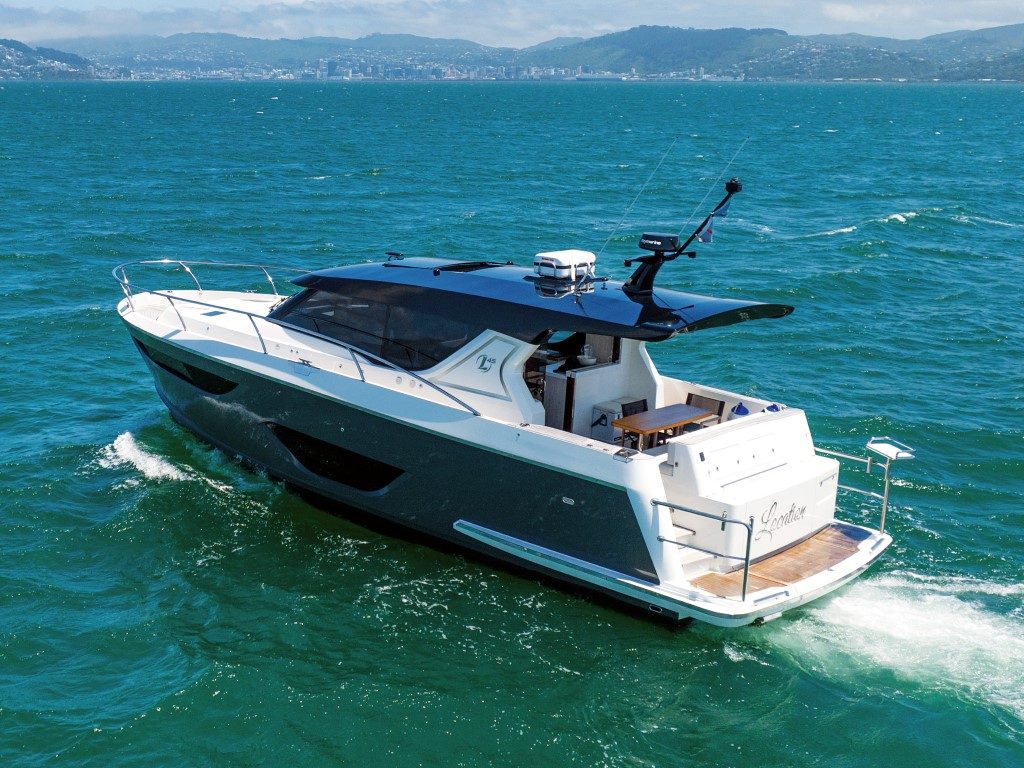
Hull design
The hull is like that of the Legacy 35 we reviewed last year, with a fully immersed chine to avoid chine slap. It is an evolution of a hull shape that has been used for sportfishers and military boats in the past and which really comes into its own in rough seas.
The Legacy 45 was built in Whakatane by the Shaw family, which has a well-earned reputation for producing high-quality, award-winning aluminium boats, honed by over 20 years of continuous operation.
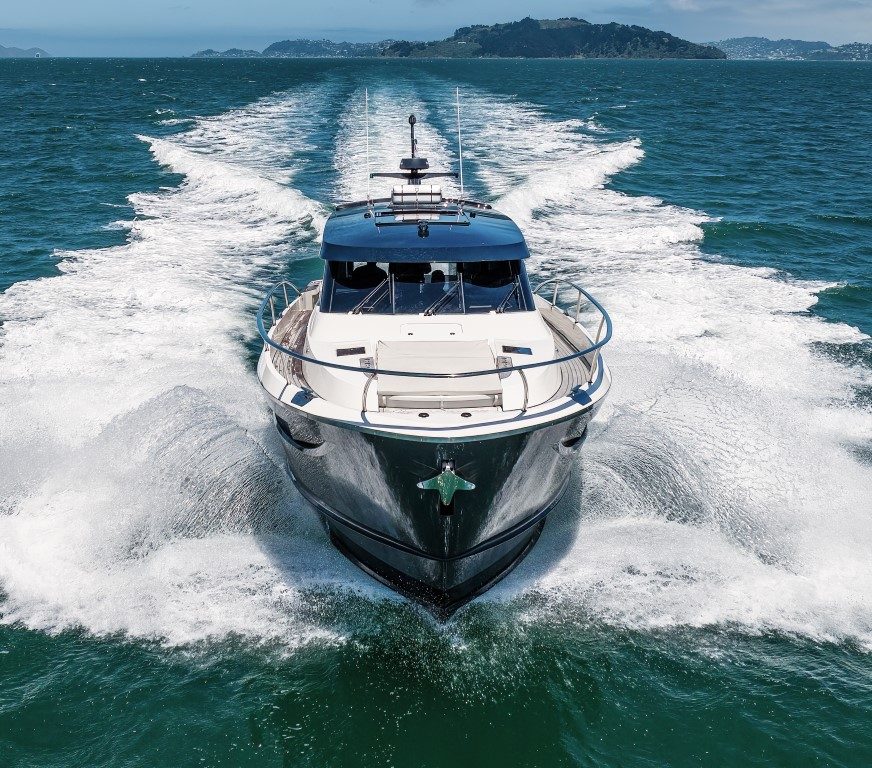
The Legacy 45 was designed by the world-famous New Zealand based LOMOcean design team. Craig Loomes, a Naval Architect, and Andrew Moltschaniwskyj, a specialist Marine Composites Engineer, are part of the brains-trust behind the design and the pair were hands-on throughout the project. This level of thinking, support, and build quality should give any Legacy owner peace of mind.
The L45 is designed and built to meet Lloyds standards. It sits in the middle of the Legacy range size-wise. Lloyds is an independent organisation that establishes, administers, and advises on standards for the design and construction of ships and other marine structures, such as oil rigs and bridges.
Perfect proportions
The L45 is intended to fulfil the role of a luxury motoryacht capable of operating in typical New Zealand coastal conditions. The layout lends itself to entertaining family and friends on the water. That said, plenty of fishing action is possible, too – the live bait tank on the port side should certainly help with that.
The deck is accessible to walk around on both sides, bordered by a large stainless steel bow rail. The bow area has a large double day bed and comes complete with drink holders and a spot for the sun umbrella.
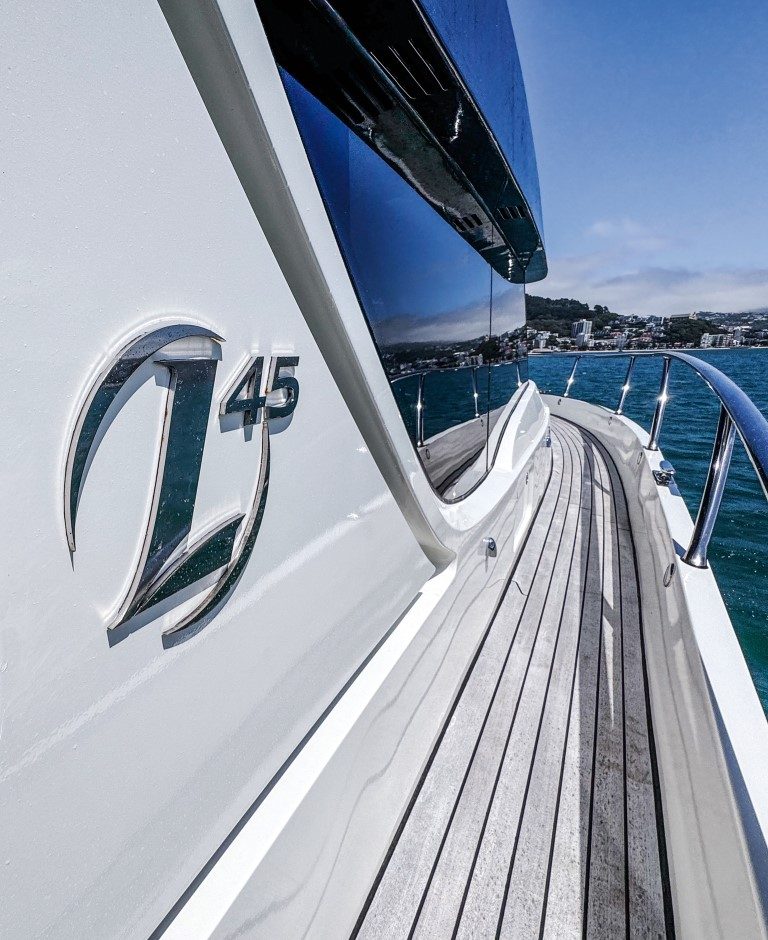
The Legacy 45 features two large cabins, each with spacious bathrooms housing a head, vanity with basin and shower facilities. Both cabins offer views outside via large side windows and each cabin has a large island bed, a wardrobe, and lots of storage space. The master suite also has a small sofa.

In the saloon, the dining table is large enough to seat four or five adults and the galley is well-proportioned with a large sink and generous bench space. There is enough refrigeration capacity for a family to spend two or three weeks away before fresh produce might be needed.
The twin captain chairs at the helm station were comfortable and gave excellent visibility around the boat. The hard top has a reasonably sized Webasto sliding sunroof for light and ventilation.
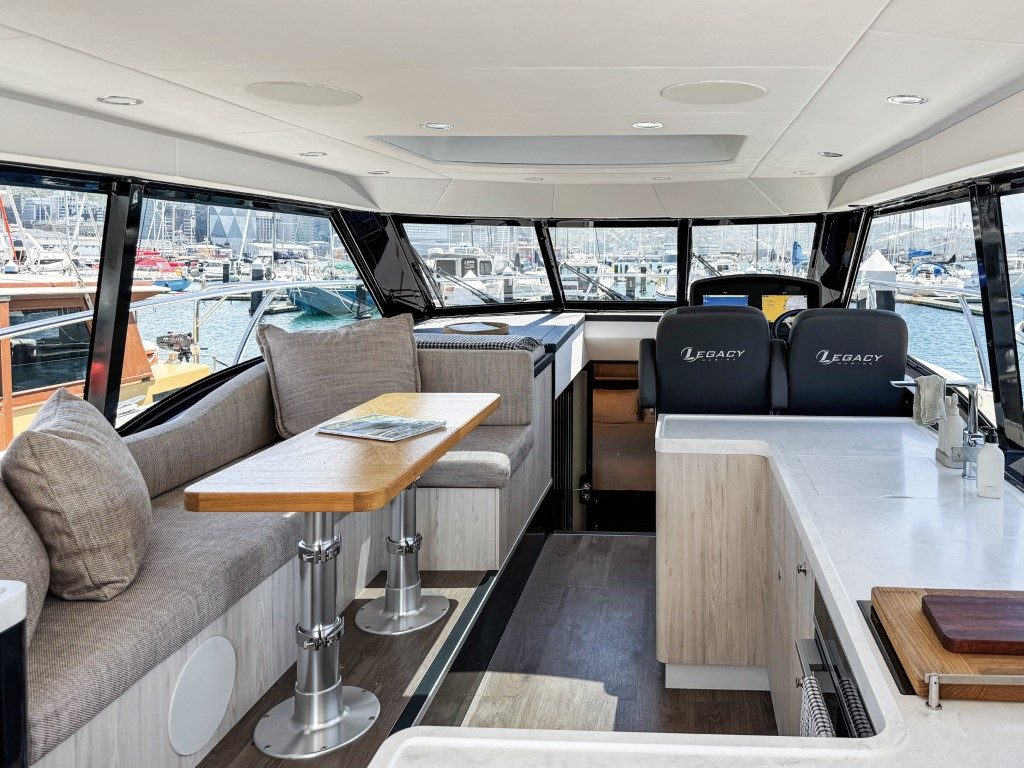
The front windscreen is in three sections for strength, each with its own windscreen wiper. The dashboard gave thoughtful clarity to the twin Raymarine screens, which have the typical array of functions, including radar and a powerful 1kW transducer for the sounder/fishfinder. This boat was equipped with CZone digital switching, with panels to operate the system seemingly everywhere for easy accessibility.

Outside, the rear cockpit has enough al fresco dining space for six and is nicely connected to the boat’s interior by large sliding doors and an oversize electric window. That said, air conditioning ensures it’s comfortable inside when its either too hot or too cold outside.
The cockpit has an electric BBQ, powered by the onboard Genset, along with a chest freezer, which is an excellent place to store food for longer voyages or fishing bait and a crew’s catch.
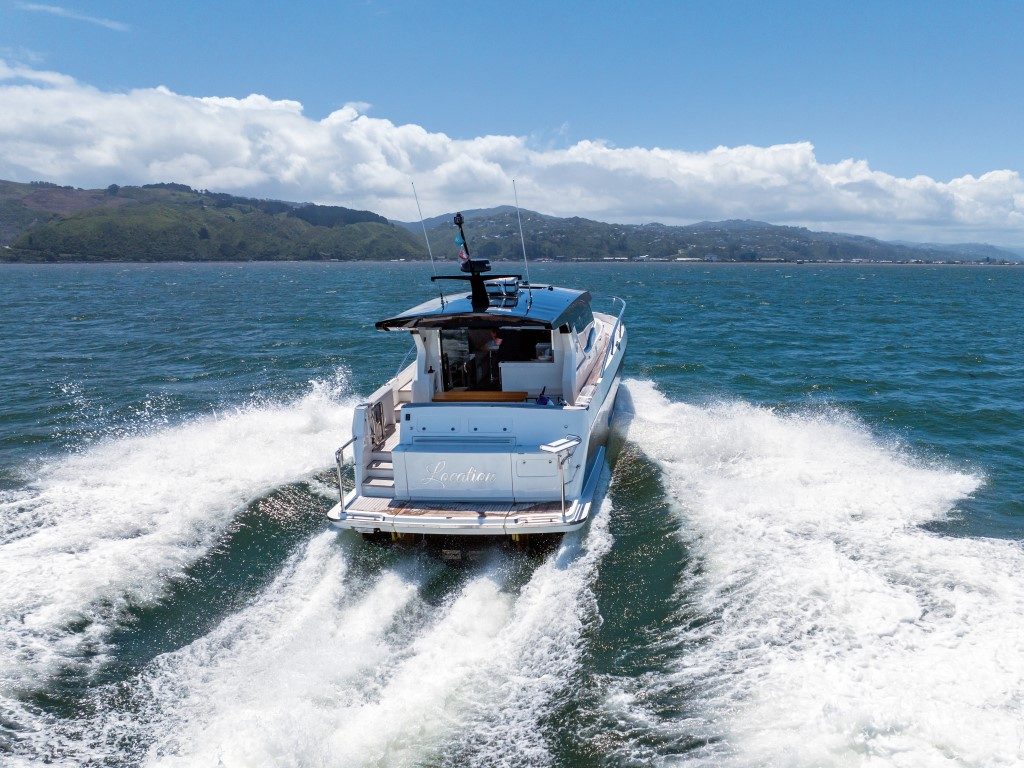
The swim platform is full beam and low enough to the water to be used for swimming and climbing back aboard again. The transom steps leading up from the platform to the cockpit are significant and safe, with the walk-around bounded by a sturdy two-inch thick rail – safe for fishing, too. A saltwater deck wash to starboard and a hot/cold freshwater shower to port completes the cockpit facilities.
Equipment and engineering
With a deadrise angle of 16 degrees, the Legacy 45 has an overall length of 13.80m, fitting easily into a 14-metre berth. This size helps keep down the operating costs when compared to vessels that need a 15-metre berth or larger. With a beam of 4.40 metres and a draft of 1.0 metres, this vessel is well suited to overnighting on the water with family. With a wet weight of about 20 tonnes, the boat feels solid and inspires confidence.
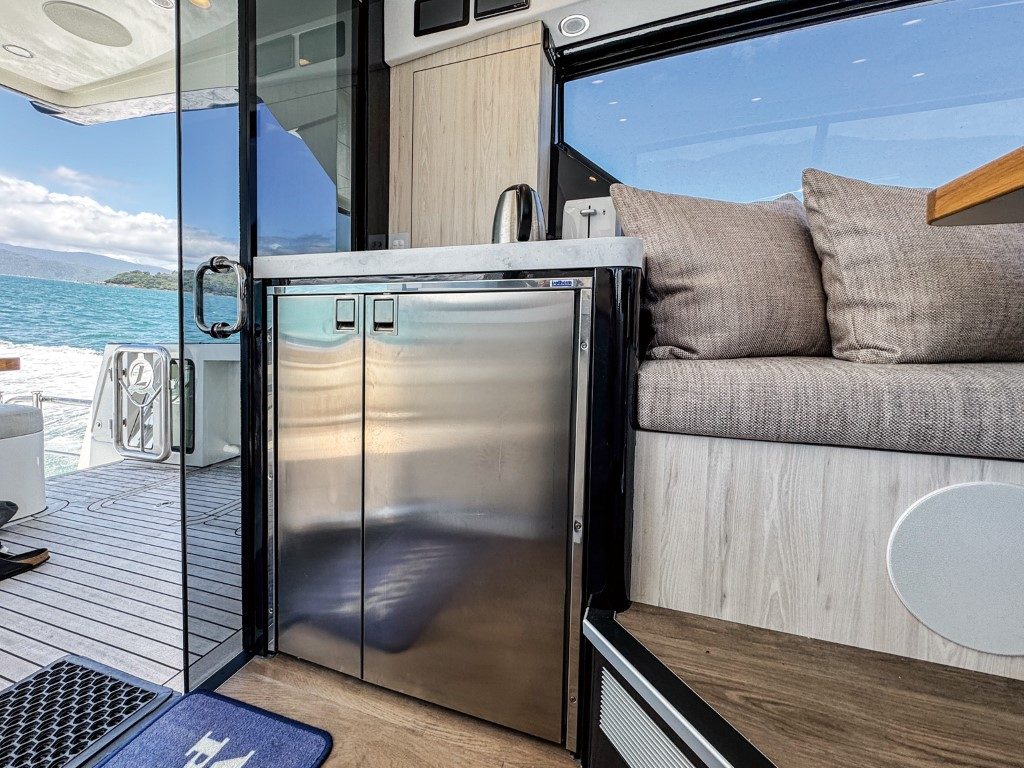
The L45 as reviewed had twin Volvo D6-IPS650s, each with 480hp. The engines have been mated with seven-bladed propellers. IPS drives give excellent manoeuvrability at all speeds, so neither stern nor bow thrusters are required.

The Volvo Penta IPS system is a fully integrated engine, drive, and control package designed from the ground up to replace traditional inboard straight-shaft drive systems. Some of the most essential advantages of powering a boat with IPS include better top speeds, improved fuel efficiency, better use of internal space, and lower noise levels.
The most noteworthy part of the IPS system is the pod drives. Rather than having a shaft running through the hull, IPS uses pod drives mounted in the hull bottom with forward-facing, twin contra-rotating propellers on each pod. While it certainly looks unusual to have the propellers forward of the lower drive unit, the propeller blades can operate without the usual hydrodynamic interruptions that can cause cavitation. It also places the propellers on a parallel plane with the hull, eliminating the typical loss of efficiency angled shafts suffer. Exhaust gases are expelled out of the back of the pod, to be carried well behind the boat in the propwash.

Another very unusual feature of these drives is that, as opposed to fixed shaft drives, the pods can rotate through 180 degrees. That means they can be turned to walk a boat sideways in either direction. Better yet, they articulate independently, allowing for complete and accurate joystick control, whether you want to spin the boat on the spot, move it sideways, forward or aft, or do a little of each simultaneously.
The test boat is fitted with two sets of joystick controls, allowing the skipper to choose which station best meets the needs of any situation, e.g. docking, when the aft station might be preferred.

With the IPS system there’s also no need for rudders, leaving more usable space inside the hull for storage or a tender garage, which is what this Legacy 45 sports.
The engine room has two access options, the first from the rear deck and the second from a sealed door in the master cabin. This provided excellent access to the boat systems, such as the water maker, Seakeeper gyro stabilisation system, generator, and engines.
Pod drives cost more to buy than conventional shaft installations, and they can be more expensive to maintain, but the test of time has proven they’re reliable and offer significant advantages. These advantages were being fully exploited by our test boat.

Performance
With the fuel tank topped up to its full capacity of 2000 litres, the fuel burn was 18 litres per hour at of 7.1 knots boat speed. The Zipwake system worked effectively at a slow planing speed to set the optimal trim for the conditions and the load. At 2500rpm and 11.5 knots the total fuel burn was 76.7 litres per hour. The test boat moved along at 24 knots at wide open throttle in moderate conditions, using 182 litres per hour. With a clean hull and good trim from the Zipwakes, the vessel can sprint to 28.5knots. Overall, this is efficient cruising for a motorboat of these proportions.

During the test run back to the marina, we ran at 20 knots in 20-knots-plus of Wellington wind, which created a moderate chop. The ride was smooth for the conditions and surprisingly quiet. Those Zipwakes helped get the trim right, but the hull performance shone through.
Versatility
The L45 design is a clear example of what is possible with thoughtful design. The test boat is well finished and nicely set up, so it should easily be the pride and joy of a couple or a family wanting long weekends away enjoying cruises to different waters around our coastline.
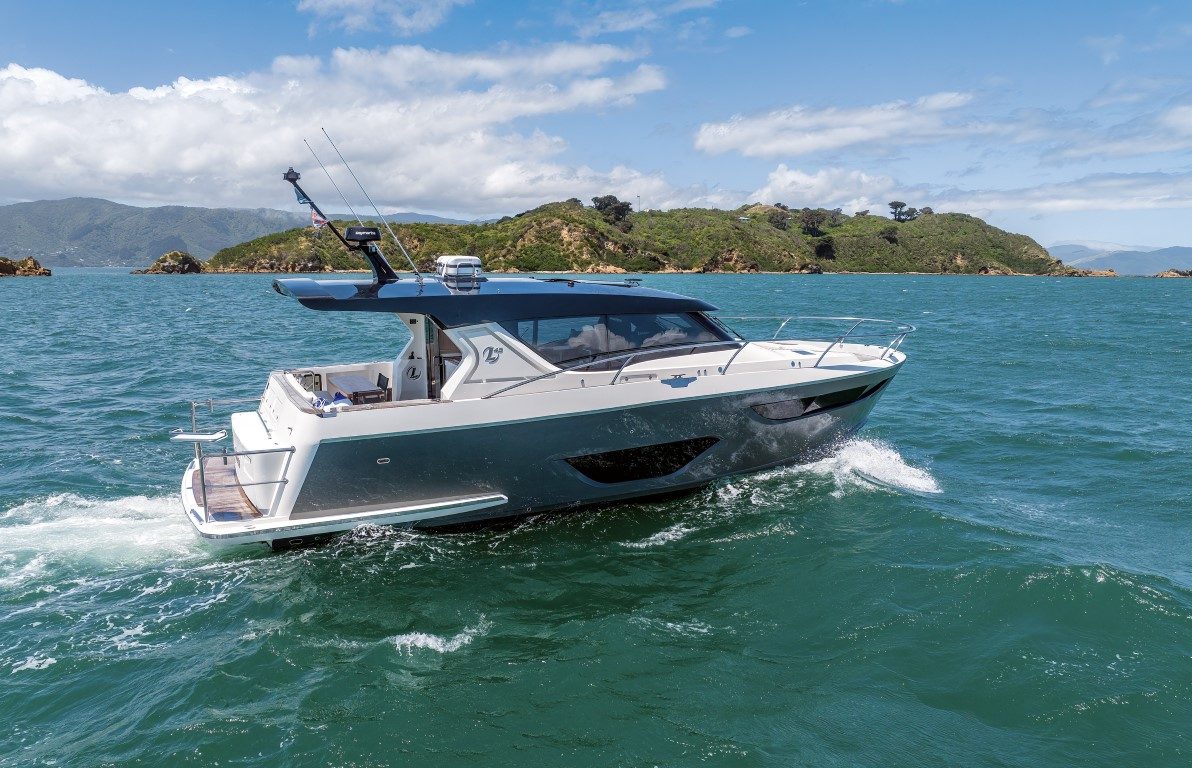
For the weekend angler and diver, this boat will deliver, too. The shape and size of the rear cockpit mean that you can fish several people at a time or fish by yourself while others relax around the cockpit in the sun.
It is said that beauty is in the eye of the beholder, but this craft sure did look good to those of us there on test day!/>
‘Behemoth’ is a word which springs to mind or, perhaps more nautically, ‘leviathan’.
White Pointer has earned the respect of discerning customers in New Zealand and Australia, attracting a loyal and ever growing following for its high-quality, rugged and totally dependable aluminium trailer boats.
The hardtop SP635 shares the same underpinnings as the popular SF 635 which was a completely new model back in 2020.
The pride and joy of a multi-generational family, Bliss resides on a pier that’s home to a couple of other Elite motor launches – Sandspit Marina is a hot-spot for the Bill Upfold-designed vessels, with several calling this small marina home.